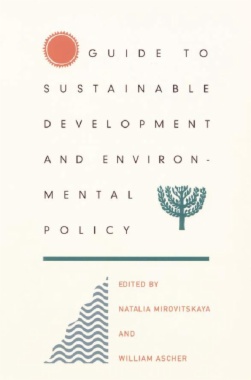The Guide to Sustainable Development and Environmental Policy is a comprehensive presentation of definitions, philosophies, policies, models, and analyses of global environmental and developmental issues. With a wealth of comparative, multidisciplinary, and geographically varied perspectives on environmental governance, it also provides detailed and balanced discussions about specific environmental issues.
The guide combines formal, objective entries with critical commentaries that emphasize different opinions and controversies. With succinct explanations of more than a thousand terms, thoughtful interpretations by international experts, and helpful cross-referencing, this resource is designed to serve as a roadmap for understanding the issues and debates in the overlapping fields of environment and development. Intended for use by activists, journalists, policymakers, students, scholars, and interested citizens, the Guide to Sustainable Development and Environmental Policy will be a helpful tool for anyone trying to get a comprehensive look at the many environmental organizations, schools of thought, development programs, international environmental treaties, conventions, and strategies that have proliferated in the past few decades.
- Contents
- Introduction
- Contributors
- 1 BASIC CONCEPTS OF DEVELOPMENT AND ENVIRONMENT
- 1.1 Development Theory: Introductory Concepts, Criteria, and Measurements
- 1.1.1 Capital
- 1.1.2 Classfication of Nations and Major Political Units by Development Characteristics
- 1.1.3 Development
- 1.1.4 Economic Production, Investment, and Cycles
- 1.1.5 Human Resource Development
- 1.1.6 Measurements of Economic Development and Growth
- 1.2 Natural Resources and Environmental Services
- 1.2.1 Carrying Capacity
- 1.2.2 Ecosystem
- 1.2.3 Environmental Services
- 1.2.4 Other Basic Environmental Concepts and Processes
- 1.2.5 Resource Uses and Types
- 1.2.6 Resource Conservation: Approaches and Practices
- 1.2.7 Standards and Measurements
- 1.3 Epistemology of the Field
- 1.3.1 Approaches to Knowledge andTheory
- 1.3.2 Environmental Studies and Economic Thought
- 2 SUSTAINABILITY
- 2.1 Basic Sustainability Concepts
- 2.2 Measurements of Sustainability
- 2.3 Philosophical Approaches and Social Movements
- 2.4 Sustainable Development Outlooks and Models
- 2.5 Sustainable Development Strategy and Agenda Statements
- 2.6 Sustainable Society: Challenges, Institutions, and Mechanisms
- 3 MAIN FACTORS BEHIND DEVELOPMENTAND ENVIRONMENTAL CHANGE
- 3.1 Population, Poverty, and Underdevelopment
- 3.2 Affluence and Consumption
- 3.3 Technology
- 3.4 Political Economy
- 3.4.1 Externalities
- 3.4.2 Property and User Rights
- 3.4.3. Scarcity
- 3.5 Worldviews and Social Traps
- 4 INTERNATIONAL POLITICAL ECONOMY OF ENVIRONMENT AND DEVELOPMENT
- 4.1 Globalization
- 4.2 Capital Shortages and Foreign Debt
- 4.2.1 Practices, Trends, and Problems
- 4.2.2 Debt Relief
- 4.2.3 Multilateral Lending Institutions
- 4.2.4 Foreign Assistance
- 4.3 International Trade
- 4.3.1 Practices, Trends, and Problems
- 4.3.2 Responses and Strategies
- 4.3.3 Global Trade Integration Initiatives
- 4.4 Regional Economic Cooperation and Integration
- 4.5 Security and Sustainable Development
- 5 DECISION MAKING
- 5.1 Analytical Tools for Environmental Decision Making
- 5.1.1 Adjusting National Accounts to Reflect Environmental and ResourceConsiderations
- 5.1.2 Benefit-Cost Analysis
- 5.1.3 Ecosystem Management and Land-Use Planning
- 5.1.4 Environmental Impact Assessment and Tools
- 5.1.5 Information and Monitoring
- 5.1.6 Planning
- 5.1.7 Valuation of Environmental Services and Natural Resources
- 5.1.7.1 Value Concepts
- 5.1.7.2 Valuation Techniques
- 5.2 Environmental Policy Instruments and Principles
- 5.2.1 Direct Environmental Regulation and Politics
- 5.2.2. Market-Based Instruments
- 5.2.2.1 Principles of Charges and Taxation
- 5.2.2.2 Instruments of Charges and Taxation
- 5.2.3 Other Environmental Protection Actions
- 5.2.4 Environmental Policy Principles and Initiatives
- 5.2.5 Policy Failures
- 5.3 Business Sector Responses to Environmental Problems
- 5.3.1 Technological Responses
- 5.3.2 Eco-Efficiency and Voluntary Codes
- 5.3.3 Environmentally Sensitive Business Management
- 5.3.4 Business Organizations and Initiatives Related to Environment
- 5.4 Population and Consumption Responses
- 5.5 International Environmental Management
- 5.5.1 Basic Concepts and Analytical Approaches
- 5.5.2 Global Conferences onEnvironment and Development
- 5.5.3 International Agencies and Commissions
- 5.5.4 International Environmental and Sustainable Development Research
- 5.5.5 International Legal Initiatives
- 5.5.6 Major Nongovernmental Organizations and Movements
- 6 MAJOR PROBLEMS OF ENVIRONMENTAL DEGRADATION AND DEVELOPMENT
- 6.1 Agricultural Decline and Pollution
- 6.1.1 Agricultural Trends, Practices,and Problems
- 6.1.2 Agricultural Responses and Strategies
- 6.1.3 Organizations Related to Agriculture
- 6.2 Air Pollution
- 6.3 Biodiversity Loss and Conservation Efforts
- 6.3.1 Biodiversity Concepts, Trends, and Conditions
- 6.3.2 Responses and Strategies
- 6.3.3 International Agreements and Organizations Related to Biodiversity Conservation
- 6.4 Climate Change
- 6.4.1 Climate Concepts, Trends, and Conditions
- 6.4.2 Conventions and Institutions Related to Climate Issues
- 6.5 Deforestation and Forestry
- 6.5.1 Forestry Trends, Practices, and Problems
- 6.5.2 Responses and Strategies
- 6.5.3 Organizations Related to Forestry
- 6.6 Desertification
- 6.7 Energy Shortages and Pollution
- 6.7.1 Energy Trends, Practices, and Problems
- 6.7.2 Energy Responses and Strategies
- 6.8 Fresh Water Scarcity and Pollution
- 6.9 Global Environmental Change
- 6.10 Hazardous Wastes
- 6.11 Natural and Humanmade Disasters
- 6.12 Ocean’s Resource Use and Degradation
- 6.12.1 Jurisdictional Issues
- 6.12.1.1 Boundary Concepts and Issues
- 6.12.1.2 Maritime Conventions, Programs, and Implementing Institutions
- 6.12.2 Coastal Processes and Management
- 6.12.3 Fisheries
- 6.12.3.1 Trends, Practices, and Problems
- 6.12.3.2 Responses, Strategies, and Institutions
- 6.12.4 Marine Environment
- 6.12.4.1 Marine Pollution
- 6.12.4.2 Marine Pollution Conventions and Their Implementing Institutions
- 6.12.5 Marine Scientific Research
- 6.12.6 Mineral Resources of the Oceans
- 6.13 Outer Space and Electromagnetic Spectrum
- 6.13.1 Trends, Practices, and Problems
- 6.13.2 Responses and Strategies
- 6.13.3 Organizations and Initiatives Related to Outer Space
- 6.14 Ozone Depletion
- 6.15 Transportation Energy Consumption and Pollution
- References
- Index

